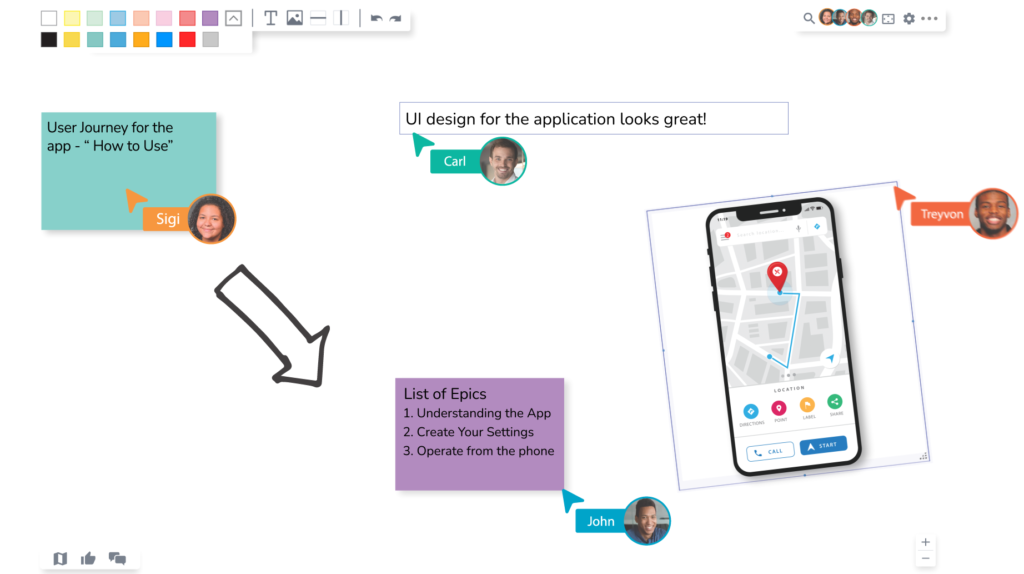How to choose an online whiteboard that’s right for you

The use of online whiteboards has really become prevalent over the past year due to the covid pandemic. People need to replicate the experience of working together visually at a whiteboard in a new digital way. There are countless options available on the market today that each have their own pros and cons. Here are a select few that are leaders in various market segments:
- CardBoard – great as a freeform canvas and with user story maps
- Google’s Jamboard – good free option with minimal features
- Microsoft Whiteboard – great for Windows hardware and surface hub devices
- Miro – good for presentations and UX teams
In this article we go over some of the key points when selecting an online or virtual whiteboard. Several of them offer free trials so be sure to test drive each one before picking an option that is best for you.
How easy is it to collaborate with other people?

One of the first things to look for in an online whiteboard is how the app allows you to collaborate with other people. Some offer audio and video conferencing capabilities while others allow you to share your screen in video apps like Zoom, Teams or Google Meet. Unless you plan on only using a whiteboard by yourself, it will be important to evaluate the experience with other people. How easy is it to add post-it notes, text, images, etc? Can different people add content at the same time?
Another thing to consider is how easy is it to add other users. Several apps will require each user to create their own account before they can collaborate with you. You should consider whether you need to restrict access to your online whiteboards or make certain users read-only.
How secure is your data and where is it being stored?
Security is an easy thing to overlook. We all love how easy it is to work with apps in the cloud, but do you know how secure your data is? Do you even know what country it is being stored in? Security breaches are a real thing in today’s business world. You never want to put yourself where your data can be compromised. I recommend you contact the manufacturer and ask them the following questions:
- Where will my data be stored at?
- Is my data encrypted at rest in the database?
- Do you offer Single Sign On (SSO)? SSO allows your teams to use your own company’s Identity Provider (your IT department will want this) and they won’t have to create a new account.
- If you are in a regulated environment, does the online whiteboard tool run in AWS GovCloud?
- Does the manufacturer have policies and procedures they are willing to share with you?
- Will the manufacturer notify you in case of a data breach?
- What is the manufacturer’s disaster recovery plan? The last thing you want to do is log in and find out that all of your data is gone 😥.
What types of content do you want to add to your online whiteboards?

One thing you want to consider is the types of content you want to upload to your digital whiteboard. Most of them offer the capability to add images, text and post-it notes, but what else do you plan to upload? Consider these types of content that you may want to add to your digital whiteboard:
- Post-it notes or sticky notes – brainstorming, story boards/maps and capturing ideas
- Images – quickly show ideas or screen shots
- Connectors/Arrows – for flowcharting or showing relationships
- Voting – to vote on topics for retrospectives
- PDF and documents – to show more content
- Shapes – for flowcharting or illustrating
- Text – to write important ideas down on the board
Do you need to export your online whiteboard to other formats?
After you have completed your masterpiece and you want to save it, does the app offer ways to export it? You will want to look for an app that allows you to save your whiteboard as a PNG or preferably a vector graphics file (PDF, SVG). The vector graphics file format is important so that when you zoom in, your content will look sharp. Vector formats store data in paths which allows them to be enlarged without losing any quality.
You might want to also consider if you’ll need your data in a textual format (e.g. TXT or CSV) so that you can work with your data in other tools like excel. If you have developers who want to get or save data to a digital whiteboard through a programatic interface, then you’ll want to make sure the app you choose has an API. API stands for Application Programming Interface. Basically, it allows software developers to pull data out or send data to your whiteboard. This can be really helpful for automation or building integrations between other tools.
What are my use cases for using an online or virtual whiteboard?
The last thing you should consider is what you are planning to use the online whiteboard for. There are many use cases and you should definitely sign up for free trials and make sure the products you demo meets your needs. Here are some popular use cases to help you identify those needs effectively:
- Brainstorming and Ideation – techniques to help collect ideas from your team
- Taking notes from meetings – document important decisions and action items
- User story mapping – plan out the customer experience for your product
- Agile planning – program increment planning, sprint planning and retrospectives
- UX research and design – better understand your users through personas and empathy maps
- Team collaboration – get your teams on the same page with icebreakers and make sure everyone’s voice is heard
- Discovery workshops – getting many people together to build a new or improve upon a product
Summing it up
The market is full of different apps for online whiteboards. However, you need to take the time to define your needs and then evaluate several of them to make sure they meet your needs.
Ready to try CardBoard for yourself? Sign up to start your 14 day free trial!
Didn’t find what you need? Visit our Help Center to find answers or get in contact with our team.
